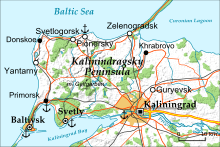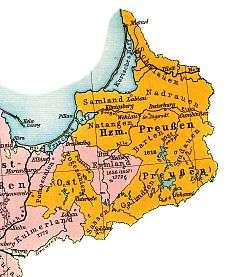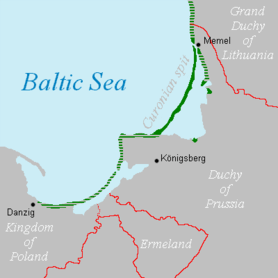Sambia Peninsula
Sambia (Russian: Самбийский полуостров, Sambiysky poluostrov, literally the Sambiysky Peninsula;Lithuanian: Sembos pusiasalis) or Samland[1] (Russian: Земландский полуостров, Zemlandsky poluostrov, literally the Zemlandsky Peninsula) or Kaliningrad Peninsula (official name, Russian: Калининградский полуостров, Kaliningradsky poluostrov) is a peninsula in the Kaliningrad Oblast of Russia, on the southeastern shore of the Baltic Sea. The peninsula is bounded by the Curonian Lagoon (to the north-east), the Vistula Lagoon (on the southwest), the Pregel River (on the south), and the Deyma River (on the east). As Samland is surrounded on all sides by water, it is technically an island. Prior to 1945 it formed an important part of East Prussia.

Names
Sambia is named after the Sambians, an extinct tribe of Old Prussians. Samland is the name for peninsula in the Germanic languages. Polish and Latin speakers call the area Sambia, while the Lithuanian name is Semba.
History

Sambia was originally sparsely populated by the Sambians. The German Teutonic Knights conquered the region during the 13th century and the Bishopric of Samland became, along with Bishopric of Pomesania, Bishopric of Ermland, and Bishopric of Culm, one of the four dioceses of Prussia in 1243. Settlers from the Holy Roman Empire began colonizing the region, and the Sambian Prussians gradually became assimilated. The peninsula was the last area in which the Old Prussian language was spoken before becoming extinct at the beginning of the 18th century.
The peninsula became part of the Duchy of Prussia when Albert of Brandenburg-Ansbach, the 37th Grand Master, was forced to secularize the Monastic State of the Teutonic Knights in 1525 and became the vasal duchy of the Kingdom of Poland. The Margraviate of Brandenburg inherited the duchy in 1618.
Because the Duchy of Prussia failed to fulfill its feudal obligations as a vassal of Poland during the Polish–Swedish wars, George William's rule in Prussia was suspended in 1635 and he was replaced by the Polish king by a viceroy, Jerzy Ossoliński. However, under the Treaty of Sztumska Wieś the Duchy (and so the Sambia peninsula) was given back to Georg William. In 1701 Hohenzollern ruler proclaimed the Kingdom of Prussia and Sambia became part of the Province of East Prussia in 1773. (The Kingdom of Prussia completed the unification of Germany by setting up the German Empire in 1871.) After World War I Sambia formed part of the East Prussian province of Weimar Germany.
In 1945 after World War II, the Soviet Union annexed northern East Prussia, including Sambia (German: Samland), while southern East Prussia was given to Poland. Sambia became part of the Soviet Kaliningrad Oblast, named after the nearby city of Kaliningrad (historically German: Königsberg), and the new authorities expelled its German inhabitants.
The Soviet Union gradually repopulated the Kaliningrad Oblast, including Sambia, with Russians and Belarusians. Until the dissolution of the Soviet Union in 1991, much of the district was a closed military area.
Kursenieki

While today the Kursenieki, also known as Kuršininkai are a nearly extinct Baltic ethnic group living along the Curonian Spit, in 1649 Kuršininkai settlement spanned from Memel (Klaipėda) to Danzig (Gdańsk), including the coastline of the Sambian Peninsula. The Kuršininkai were eventually assimilated by the Germans, except along the Curonian Spit where some still live. The Kuršininkai were considered Latvians until after World War I when Latvia gained independence from the Russian Empire, a consideration based on linguistic arguments. This was the rationale for Latvian claims over the Curonian Spit, Memel, and other territories of East Prussia which would be later dropped.
Geography and geology
Baedeker[2] describes Samland as "a fertile and partly-wooded district, with several lakes, lying to the north of Königsberg" (since 1946 Kaliningrad). The highest point, 360 feet, is found twelve miles north of Pereslavskoe (Drugehnen) at the ski resort then called the Galtgarben.[3] There also used to be a Samland railway station. As of 2010 the Pereslavskoe railway station serves the "Blue Arrow" railway line from Kaliningrad to Svetlogorsk.
Sambia includes two famous seaside resorts, Zelenogradsk (former German name: Cranz) and Svetlogorsk (former German name: Rauschen).
Amber
Amber has been found in the area for over two thousand years, especially on the coast near Kaliningrad. History and legends tell of the ancient trade routes known as the Amber Road leading from the Old Prussian settlements of Kaup (in Sambia) and Truso (near Elbląg - German: Elbing, near the mouth of the Vistula) southwards to the Black and Adriatic seas. In Imperial Germany, the right to collect amber was restricted to the Hohenzollern dynasty, and visitors to Samland's beaches were forbidden to pick up any fragments they found. Beginning in the 19th century, amber was mined on an industrial scale by the Germans before 1945 and by the Soviets / Russians thereafter at Yantarny (former German name: Palmnicken).
See also
| Wikisource has the text of the 1911 Encyclopædia Britannica article Samland. |
Footnotes
- Samland was also the codename for the USA by the wartime intelligence agency Abwehr (Operation Mincement by Ben MacIntyre)
- Karl Baedeker, Northern Germany, Leipzig, London and New York: 1904 (fourteenth revised edition (English language)), pp.177-8.
- Some place names given here are in German.